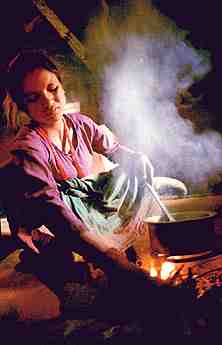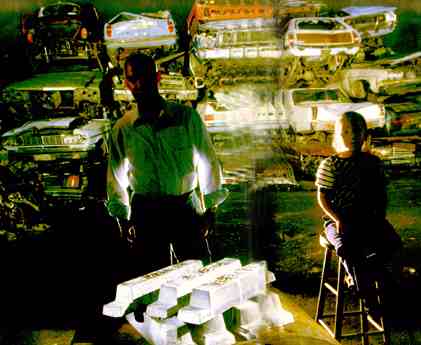
Children of smokers suffer more bronchitis and pneumonia during infancy than those of nonsmokers. In a smoking-habits survey, a University of North Carolina team found cotinine, a metabolite of nicotine, in the urine of this baby (below) and others who live with smokers. In rural Nepal (below) a cooking fire can fill a poorly ventilated house with heavier pollution than the worst urban smog, increasing risks of respiratory disease - the Third World's leading killer.


Paying the price for lead, a young girl and a middle-aged man
symbolize victims of a lead-polluted environment. The 20 automobiles stacked
behind them - including many "lead sleds" built before 1975 -- without
catalytic converters would have spewed out the equivalent of 525 pounds
of lead in exhaust fumes during their average life span of ten years.
Between 75 and 95 percent of the lead inhaled or ingested accumulates
in bones and other tissues, threatening to cause irreversible brain and
kidney damage. Young children are most vulnerable because their nervous
systems are still developing. Excessive lead can decrease a child's intelligence,
shorten his or her attention span, create learning disabilities, or cause
hyperactivity. Perhaps 20 percent of all preschool children have excessive
blood lead levels.
Elevated blood lead levels in adult males have been linked to
high blood pressure. An EPA researcher estimates that 60,000 to 70,000
heart attacks per decade might be prevented if the mean blood lead level
of all Americans was reduced by a third. The phasing out of leaded gasoline
has already helped. From 1976 to 1980, when production of lead additives
dropped by more than half, the mean blood lead level in the U.S. fell by
a third.
